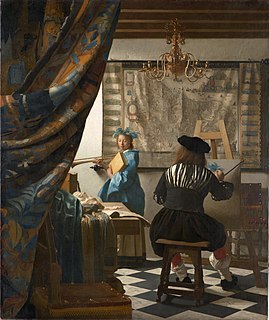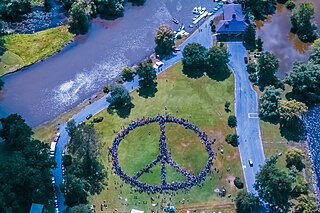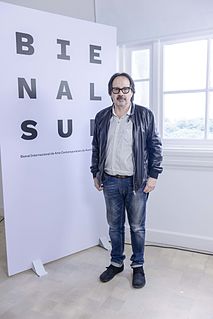
Photography is the art, application, and practice of creating durable images by recording light, either electronically by means of an image sensor, or chemically by means of a light-sensitive material such as photographic film. It is employed in many fields of science, manufacturing, and business, as well as its more direct uses for art, film and video production, recreational purposes, hobby, and mass communication.

Peace and conflict studies is a social science field that identifies and analyzes violent and nonviolent behaviours as well as the structural mechanisms attending conflicts, with a view towards understanding those processes which lead to a more desirable human condition. A variation on this, peace studies (irenology), is an interdisciplinary effort aiming at the prevention, de-escalation, and solution of conflicts by peaceful means, thereby seeking "victory" for all parties involved in the conflict.

The term composition means "putting together". It can be thought of as the organization of the elements of art according to the principles of art. Composition can apply to any work of art, from music through writing and into photography, that is arranged using conscious thought.
John Paul Lederach is an American Professor of International Peacebuilding at the University of Notre Dame, Notre Dame, Indiana, and concurrently Distinguished Scholar at Eastern Mennonite University. He has written widely on conflict resolution and mediation. He holds a Ph.D. in Sociology from the University of Colorado. In 1994 he became the founding director for the Center for Justice and Peacebuilding at Eastern Mennonite University where he was a professor. He currently works for the foundation Humanity United.
Peace journalism has been developed from research that indicates that often news about conflict has a value bias toward violence. It also includes practical methods for correcting this bias by producing journalism in both the mainstream and alternative media, and working with journalists, media professionals, audiences, and organizations in conflict.

Peacebuilding is an activity that aims to resolve injustice in nonviolent ways and to transform the cultural and structural conditions that generate deadly or destructive conflict. It revolves around developing constructive personal, group, and political relationships across ethnic, religious, class, national, and racial boundaries. The process includes violence prevention; conflict management, resolution, or transformation; and post-conflict reconciliation or trauma healing before, during, and after any given case of violence.
Visual ethics is an emerging interdisciplinary field of scholarship that brings together religious studies, philosophy, photo and video journalism, visual arts, and cognitive science in order to explore the ways human beings relate to others ethically through visual perception. Historically, the field of ethics has relied heavily on rational-linguistic approaches, largely ignoring the importance of seeing and visual representation to human moral behavior. At the same time, studies in visual culture tend to analyze imagistic representations while ignoring many of the ethical dimensions involved. Visual ethics is a field of cross-fertilization of ethics and visual culture studies that seeks to understand how the production and reception of visual images is always ethical, whether or not we are consciously aware of this fact.
Conflict transformation is a concept designed to reframe the way in which peacebuilding initiatives are discussed and pursued, particularly in contexts of ethnic conflict. Traditionally the emphasis has been on conflict resolution and conflict management methods, which focus on reducing or defusing outbreaks of hostility. Conflict transformation, in contrast, places a greater weight on addressing the underlying conditions which give rise to that conflict, preferably well in advance of any hostility, but also to ensure a sustainable peace. In other terms, it attempts to make explicit and then reshape the social structures and dynamics behind the conflict, often employing analytical tools borrowed from systems thinking. "The very structure of parties and relationships may be embedded in a pattern of conflictual relationships that extend beyond the particular site of conflict. Conflict transformation is therefore a process of engaging with and transforming the relationships, interests, discourses and, if necessary, the very constitution of society that supports the continuation of violent conflict".
Image quality can refer to the level of accuracy with which different imaging systems capture, process, store, compress, transmit and display the signals that form an image. Another definition refers to image quality as "the weighted combination of all of the visually significant attributes of an image". The difference between the two definitions is that one focuses on the characteristics of signal processing in different imaging systems and the latter on the perceptual assessments that make an image pleasant for human viewers.
Truth claim, in photography, is a term Tom Gunning uses to describe the prevalent belief that traditional photographs accurately depict reality. He states that the truth claim relies on both the indexicality and visual accuracy of photographs.
Creative peacebuilding is the larger name for artist approaches to peacebuilding within individuals, groups, and societies. It includes various forms of art therapy, whereby individuals and groups can express themselves to nurture healing and restoration. It is also used to overcome the recurrence of violence, as a preventative measure to make the foundations of peace stronger, especially in contexts of war and conflict. Creating an environment of lasting peace is the primary goal of creative peacebuilding.
An Agenda for Peace: Preventive diplomacy, peacemaking and peace-keeping, more commonly known simply as An Agenda for Peace, is a report written for the United Nations by Secretary-General Boutros Boutros-Ghali in 1992. In it, Boutros-Ghali responds to a request by the UN Security Council for an "analysis and recommendations" to strengthen peacemaking and peace-keeping. The document outlines the way Boutros-Ghali felt the UN should respond to conflict in the post-Cold War world.
Environmental peacebuilding examines and advocates environmental protection and cooperation as a factor in creating more peaceful relations. Peacebuilding is both the theory and practice of identifying the conditions that can lead to a sustainable peace between past, current or potential future adversaries. At the most basic level, warfare devastates ecosystems and the livelihoods of those who depend on natural resources, and the anarchy of conflict situations leads to the uncontrolled, destructive exploitation of natural resources. Preventing these impacts allows for an easier movement to a sustainable peace. From a more positive perspective, environmental cooperation can be one of the places where hostile parties can sustain a dialogue, and sustainable development is a prerequisite for a sustainable peace.
The Centre for Theology and Public Issues (CTPI) is a research centre based in New College, the School of Divinity at the University of Edinburgh. Founded in 1984 by Duncan B. Forrester, CTPI promotes Christian theological reflection and research on important public issues. CTPI research is global in orientation and rooted in the tradition of public theology. Issues are examined by bringing together theologians, social scientists, church leaders, policy makers and the public. CTPI has particularly close relations with the Scottish Parliament and other institutions of Scottish public life. The current director is Jolyon Mitchell.
Center for Justice and Peacebuilding (CJP) is an accredited graduate-level program founded in 1994. It also offers non-credit training. The program specializes in conflict transformation, restorative justice, trauma healing, equitable development, and addressing organizational conflict. CJP is housed at Eastern Mennonite University (EMU) in Harrisonburg, Virginia, which describes itself as "a leader among faith-based universities" in emphasizing "peacebuilding, creation care, experiential learning, and cross-cultural engagement." One of the three 2011 Nobel Peace Laureates, Leymah Gbowee of Liberia, earned a master's degree in conflict transformation from CJP in 2007.
In psychology of art, the relationship between art and emotion has newly been the subject of extensive study thanks to the intervention of esteemed art historian Alexander Nemerov. Emotional or aesthetic responses to art have previously been viewed as basic stimulus response, but new theories and research have suggested that these experiences are more complex and able to be studied experimentally. Emotional responses are often regarded as the keystone to experiencing art, and the creation of an emotional experience has been argued as the purpose of artistic expression. Research has shown that the neurological underpinnings of perceiving art differ from those used in standard object recognition. Instead, brain regions involved in the experience of emotion and goal setting show activation when viewing art.

Hizkias Assefa (1948) is a conflict mediator known widely in Africa for his non-aligned work as a consultant who has mediated in most major conflict situations in sub-Saharan Africa in the past 20 years, as well as in a dozen countries elsewhere. He is also a professor of conflict studies. Of Ethiopian origin, he is based in Nairobi, Kenya. He was one of the founding faculty members in 1994 of the Conflict Transformation Program at Eastern Mennonite University.
Emmanuel Bombande is a conflict resolution, peacebuilding, and development professional from Accra, Ghana, and is the Chair of the Board of the Global Partnership for the Prevention of Armed Conflict.
The West Africa Network for Peacebuilding (WANEP) is a leading Regional Peacebuilding organisation founded in 1998 in response to civil wars that plagued West Africa in the 1990s. Over the years, WANEP has succeeded in establishing strong national networks in every Member State of ECOWAS with over 550 member organisations across West Africa. WANEP places special focus on collaborative approaches to conflict prevention, and peacebuilding, working with diverse actors from civil society, governments, intergovernmental bodies, women groups and other partners in a bid to establish a platform for dialogue, experience sharing and learning, thereby complementing efforts at ensuring sustainable peace and development in West Africa and beyond.

Oscar Muñoz is a Colombian visual artist. He is known as one of the most significant contemporary visual artists in his country, and his work has also gained international recognition. Most of his art is concerned with the idea of representation, and his choice of art medium moves freely between photography (photorealism), printmaking, graphite drawing, installation art, audiovisual media, and sculpture. He also explores how images relate to memory, loss, and the precarious nature of human life.





